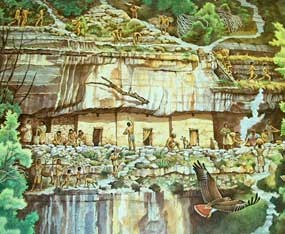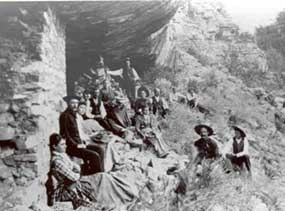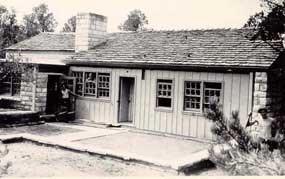Associated TribesThis entire region that includes the Flagstaff Area National Monuments have been home to Native people since time immemorial. The Flagstaff Area National Monuments (Walnut Canyon, Sunset Crater Volcano, and Wupatki) are places of immeasurable importance to Native people in the Southwest. Wupatki shares boundaries with the Navajo Nation, and a total of thirteen federally recognized tribes are traditionally associated with the Monuments. Park staff have been working with tribal people for many years and are creating ever-better collaborative tribal partnerships. As we celebrate Native heritage, please take a moment to ponder and appreciate the diverse cultural stories these lands hold. This history, played out on lands to include the Flagstaff Area National Monuments, has been dramatic and difficult - but learning from the past can help us all in the future.

Artwork by Michael Hampshire Walnut Canyon has a long human history. Artifacts show that Archaic peoples, who traveled throughout the Southwest thousands of years ago, occupied the canyon at times. Scattered families farmed the canyon rims for centuries, growing small gardens of corn, squash, and beans. During the 1100s, many moved into limestone alcoves below the canyon rim, where they constructed the cliff dwellings we see today. The Walnut Canyon community thrived for another 150 years before the people moved on. 
NPS photo Others have visited the canyon since the Ancients departed. With the construction of the railroad nearby in the 1880s, Walnut Canyon became a popular destination; scores of “pot-hunters” streamed into the canyon. Armed with shovels and dynamite, these souvenir-seekers upturned ancient floors, toppled enduring walls, and desecrated graves. The theft and destruction alarmed local citizens and led to establishment of Walnut Canyon National Monument in 1915. Remnants of the canyon’s past were protected first by the US Forest Service, then (since 1934) by the National Park Service. 
NPS photo The Civilian Conservation Corps (CCC) played a major role in the late 1930s, stabilizing walls, conducting guided tours to better protect the cliff dwellings, and constructing many of the buildings and trails we use today. Now, for more than 100,000 people every year, Walnut Canyon National Monument offers the opportunity to admire and learn from the past. With continued protection, and cooperation from visitors, this intimate canyon will educate and inspire for years to come. Its future is in our hands. |
Last updated: June 6, 2024
